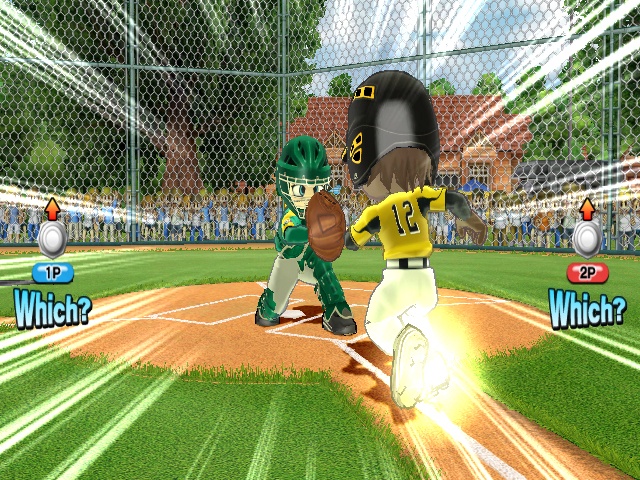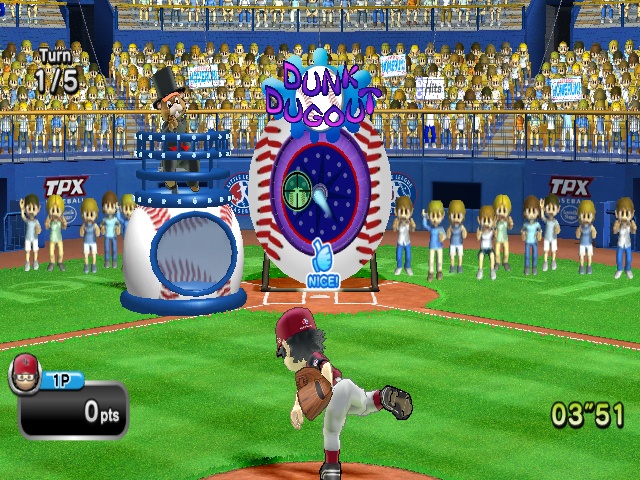Just because you're getting two games in one in Little League World Series Baseball: Double Play doesn't mean that you're getting a deal. This twin pack of the 2008 and 2009 Nintendo Wii versions of the arcade baseball games might come at a cut-rate price, but you're still getting a couple of retreads that weren't all that great when they were new. Shoehorned-in motion controls and camera issues make both games somewhat annoying to play, even though you can't help but smile at the game's shiny, happy take on little league baseball, courtesy of anime players and cutesy special effects.

What stands out the most about this doubleheader, however, is the fact that it is unnecessary. Double Play consists of two almost identical games. As usual with sports games, a single year doesn't make much difference. The 2009 edition is largely the same as the 2008 one, with only some mild improvements in a few areas and an expanded feature list. This includes special player cards that let you pull off various on-field stunts; regional qualifying tournaments, in addition to the actual Little League World Series in Williamsport, PA; and more teams from across the globe to fill out those tournaments. There actually isn't any point in ever even bothering to fire up the 2008 game. So if you can find a copy of the 2009 release on its own in a bargain bin somewhere, you would be well advised to snap that up instead of this combo.
Or not. Little League World Series Baseball is tough to enjoy on the Wii no matter what price you pay. The biggest problem has to do with the flawed motion controls. As with other Wii baseball games, the controls mimic swinging a bat and throwing a ball with your Wii Remote in hand. When hitting, you flick the controller from one side to another; when pitching, you pull the controller back and then snap it forward. Both movements are irritating. Hitting is the lesser of two evils because it's awfully easy to smash balls to the wall with a quick flick of the wrist. Still, it can also give you carpal tunnel pains due to the repetitive motion. Pitching is far worse because it features a very similar strain on your hand, as well as a touchy sensor that frequently ignores when you bring the remote back to start your windup. You typically have to make two or three attempts to begin that motion. Controls are not very sensitive when pushing forward to throw the ball, either, which causes you to mistime your release and chuck meatballs down the middle of the plate. Neither movement is anywhere close to providing the illusion that you're simulating real baseball, so you quickly want to turn to the classic controls offered in the 2009 version of the game.
Most of the appeal here comes from the feature set and frills. You get a thorough re-creation of the little league experience. The main solo mode of play lets you take a team from the regionals all the way to the big show in Williamsport, while skill challenges test your acumen in games ranging from a fairly generic home-run derby to more exotic treats like Pitching Bowling and the Around the Horn memory contest. Local multiplayer support lets up to four players get in on the action, too. Teams are fully stocked with players, and they all have different names, skill ratings, and even personal favorites, like food and movies. Some of this is a little random, as it's awfully hard to imagine a kid named Matt from the northeastern US having a predilection for kimchi, but the abilities and traits let you identify with your team of tykes over the long haul to the finals. Extra arcade spice is sprinkled on top of games as well. On-field success is rewarded with points that max out a talent bar and allow you to trigger buffs that improve chances to hit, throw strikes, and make crazy plays in the field. Special player cards that let you pull off killer moves also jazz things up because you can use them to up the odds of hitting a home run, a line drive, and so on. Both features actually add a layer of tactical thinking to games because you have to be careful when using them to maximize your chances of scoring.

The distinctive appearance of the Little League World Series franchise gives everything even more of a unique appeal. All of the players have an anime appearance, with big heads, huge eyes, and spiky hair. It's a very distinctive look, especially when coupled with the brightly colored stadiums where the sun shines all day and the sky is so blue it almost hurts. But it's also polarizing because you'll either love it or hate it. The stylized kiddie vibe of everything is hard to reconcile with a respected real-world event like the Little League World Series. Anyone interested in the real thing would likely want a more realistic game, and those who don't care about it wouldn't be interested in the license. So you have to wonder who the target audience is here. Camera problems also get in the way. The viewing angle locks fairly tightly onto hit balls, making it tough to tell what to do in the field. If not for the mostly automatic fielding, you'd have an awful time catching even routine pop-ups. Audio isn't nearly as outrageous. You get to listen to a lot of crowd noise, as well as Jim Thorne and Brent Musburger reading off player numbers, strikes, and balls in the 2009 game, but that's it.
Double Play should be scored an error. The twin package doesn't make much sense, and the control and camera issues in the game can make for one frustrating time on the diamond. Yes, you're getting two games for the price of one, but you're unlikely to ever play one of them, and if you're interested in last year's game you're better off looking for a standalone copy of it.